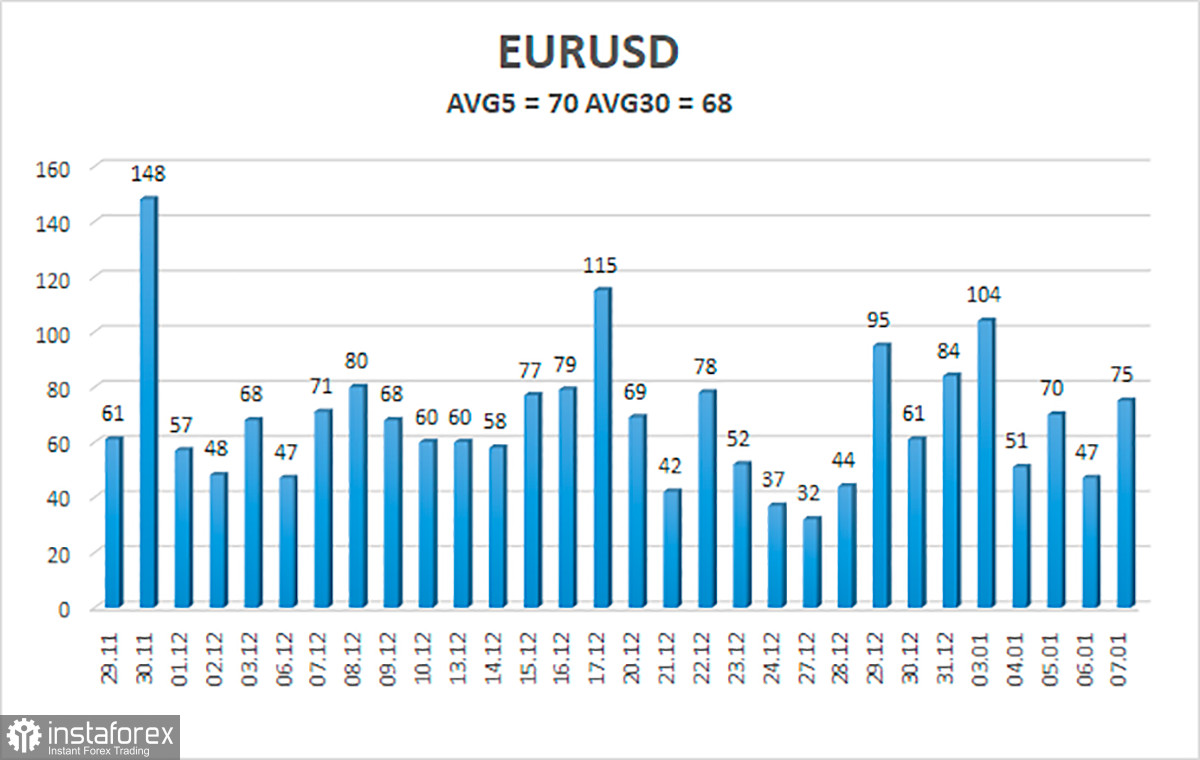
The EUR/USD pair showed some movement on Friday only in the second half of the day. Important reports such as Nonfarm Payrolls in the US and inflation in the EU had no effect on the quote, and the pair remained in the sideways channel. The price has been moving sideways for over a month and a half. In other words, important fundamentals had no influence on the market again, and the formation of a new trend was impossible. Nevertheless, the pair has been showing a slight upward movement over the indicated period, according to the lower linear regression channel. So, just approximate limits of the sideways channel could be established. Since the price is within the range of 1.1230-1.1353 (the Murray levels of 0/8 and 2/8 respectively) most of the time, they could be considered the limits. Although, the price rarely bounced from them while being flat. This means that traders should wait for the end of the flat or use a lower time frame, hoping for the formation of intraday trends. Technically, nothing has changed and the pair may trade sideways for a few weeks more.
Inflation in the eurozone to slow down by the end of 2022
In the past few months, trades focused solely on any news on monetary policy in the US and the Federal Reserve. Meanwhile, ECB President Christine Lagarde made it clear that the EU economy was weak to curtail stimulus and raise interest rates in 2022. So, market participants do not expect any actions from the European regulator in the coming months. Therefore, the market shows no reaction to statistics in the eurozone. Traders' sentiment in the forex market depends heavily on the monetary policy of each central bank and related expectations. So, market players now anticipate the Federal Reserve to end the winddown of the QE program in March 2022, raise interest rates, and even launch a sell-off of the government bonds it accumulated during the pandemic. These are hawkish steps. That is why traders have fundamental reasons for continuing to purchase the greenback. It is unlikely that the dollar will keep rising based on this factor only. After all, more cash was injected into the American economy than the European one. However, if the Federal Reserve keeps its hawkish stance on monetary policy, the dollar may extend gains this year.
At the same time, the eurozone's inflation report caused no reaction in the market. In the US, accelerating inflation indicated that the regulator would speed up the pace of QE taper and hike interest rates, thus boosting the greenback. Meanwhile, growing inflation in the EU meant nothing. In addition, ECB Chief Economist Philip Lane said on Friday that inflation would slow down by the end of 2022. He linked the current inflation hike with the pandemic and its adverse consequences. Mr. Lane also repeated Christine Lagarde's words that interest rates were unlikely to be raised this year and underlined that rising energy prices were a major issue. Generally speaking, fundamentals in the eurozone have little effect on the market than those in the US. The euro is still unable to show growth, so there is a strong likelihood of a downtrend.

On January 10, the volatility of EUR/USD totals 70 pips. Today, the pair is expected to move in the range between 1.1291 and 1.1430. Heiken Ashi's downward reversal is likely to indicate the start of a downtrend within the range of 1.1230-1.1353.
Closest support levels:
S1 – 1.1292
S2 – 1.1230
S3 – 1.1169
Closest resistance levels:
R1 – 1.1353
R2 – 1.1414
R3 – 1.1475
Outlook:
The EUR/USD is still moving within the sideways channel of 1.1230-1.1353. So, trading could be difficult due to a flat market. The pair may consolidate above the channel on Monday, which could be interpreted as a buy signal. Nevertheless, the upside potential is minimal. Therefore, the euro/dollar pair is unlikely to show significant growth.
Indicators on charts:
Linear Regression Channels help identify the current trend. If both channels move in the same direction, a trend is strong.
Moving Average (20-day, smoothed) defines the short-term and current trends.
Murray levels are target levels for trends and corrections.
Volatility levels (red lines) reflect a possible price channel the pair is likely to trade in within the day based on the current volatility indicators.
CCI indicator. When the indicator is in the oversold zone (below 250) or in the overbought area (above 250), it means that a trend reversal is likely to occur soon.





















